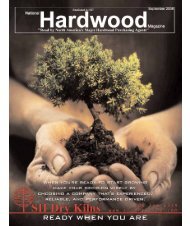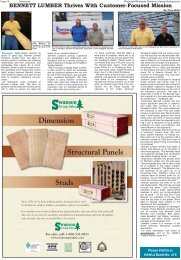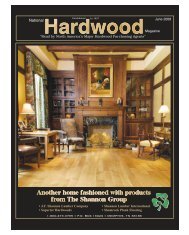Gilco Lumber, Inc.... - Miller Publishing Corporation
Gilco Lumber, Inc.... - Miller Publishing Corporation
Gilco Lumber, Inc.... - Miller Publishing Corporation
Create successful ePaper yourself
Turn your PDF publications into a flip-book with our unique Google optimized e-Paper software.
QUEBEC<br />
The marketplace continues to be slow paced and highly competitive<br />
for North American Hardwoods. Mills are reported to be operating<br />
with adequate log decks to supply the current demand, though<br />
log supplies have been generally lower than normal. At this time,<br />
much of the green lumber production is concentrated on<br />
Whitewoods. Buyers are still using a controlled approach on purchasing.<br />
It is reported there is greater sales competition in kiln<br />
dried lumber markets. Prices are unsettled for most species and<br />
grades due to intense sales competition, along with the economic<br />
turmoil and overall market weakness.<br />
Contacts report that market activity is better for Hard Maple than<br />
for most other species; although at this time business for Hard<br />
Maple is not that great. Demand is down and buyers are controlling<br />
purchases to specific requirements. Winter cut production in March<br />
was in full swing, with log availability at sawmills having sufficient<br />
supply. The volume of green Hard Maple entering the marketplace<br />
is more than ample to fulfill buyers’ needs, which is causing<br />
price pressure.<br />
The sagging demand for Soft Maple is keeping the “supply component<br />
of the inventory-to-sales ratio” high for this species.<br />
Overall pricing for Soft Maple is trending lower. Birch’s slow market<br />
activity has been caused by the economic turmoil and the downturn<br />
in U.S. housing markets, just as they have for other species.<br />
Birch has been competing with other North American species,<br />
including Hard Maple, as well as imported species. Prices have<br />
gone down. Prices for various grades of kiln dried Birch have also<br />
dropped.<br />
Sales for Basswood continue to be based on established customer/supplier<br />
relationships, even though it is demand driven.<br />
Purchases are for items and quantities for specific purposes. With<br />
the winter cut production providing enhanced color characteristics<br />
for this and other whitewoods, there is virtually no speculative buying<br />
in anticipation of future demand.<br />
Orders and shipments for Beech are slow. Prices moved down<br />
during the past couple of months due to the overall business contraction<br />
and competition from other species. Contacts report there<br />
is limited market interest in Ash, but indicate supplies are not<br />
excessive or problematic for sellers, with prices being stable.<br />
News from suppliers about prices,<br />
trends, sales and inventories.<br />
ONTARIO<br />
Ontario posted weight restrictions earlier this spring, and Quebec<br />
followed suit. Several companies were reported having switched<br />
business, going into manufacturing railroad ties instead as their<br />
business was no longer viable.<br />
Alder is holding its market share even though volumes have fallen<br />
dramatically. Ash demand remains stable despite the very<br />
volatile markets for most other species. Basswood sales to Asia<br />
were reported as good. Although Yellow Birch sales were strong,<br />
prices were reported to be slipping. One manufacturer stated that<br />
widths and lengths for Yellow Birch were the selling factors with<br />
dramatic price effects received. Another contact stated that White<br />
Birch was the strong species showing no weakness in price and<br />
demand.<br />
According to the Royal Bank of Canada’s (RBC) annual homeownership<br />
survey of 2,026 Canadians conducted recently by Ipsos<br />
Reid, confidence appears to be seeping back into the housing market,<br />
with young Canadians the most optimistic that now is a good<br />
time to buy. Sixty-five percent of respondents believe it is a buyers’<br />
market now. Of those surveyed, 9 percent said it is “very likely”<br />
they will purchase a home or condominium in 2009 or 2010,<br />
and another 18 percent rated the prospect of purchasing a new<br />
home as “somewhat” likely. Additionally, almost half indicate it<br />
makes sense to buy a home now versus waiting until next year.<br />
Young adults and renters are most likely to spark an upsurge in<br />
home sales, stated RBC in its survey results. Forty-eight percent of<br />
the under-35 group said they plan to buy and 38 percent of renters<br />
plan to become homeowners in the next two years. Although this<br />
optimism is not reflected in the most recent sales statistics – the<br />
volume of sales in the Toronto area, for example, was down 47 percent<br />
year-over-year in January – RBC predicts that lower prices<br />
will lure a growing percentage of Canadians back into the housing<br />
market in the next two years.<br />
A Toronto real estate agent notes that consumers do not always<br />
follow through on their intentions – although it is encouraging that<br />
more Canadians appear to be thinking about buying homes. RBC’s<br />
head of home equity financing, said low mortgage rates “and favorable<br />
housing prices are influencing home purchase intentions this<br />
year and may be the reason why more Canadians are poised to pur-<br />
Please turn to page 61 Please turn to page 61<br />
8 Hardwoods Have Workability

















